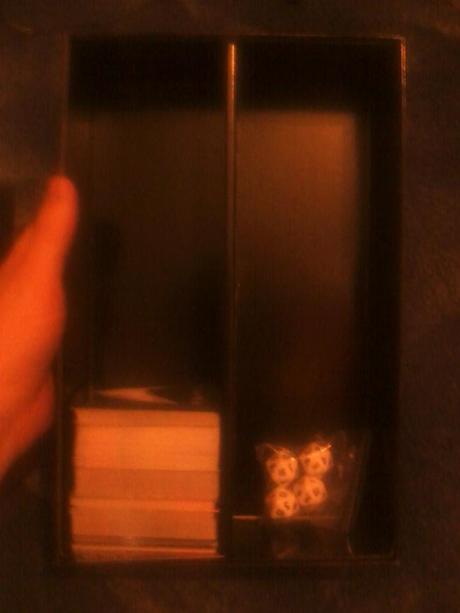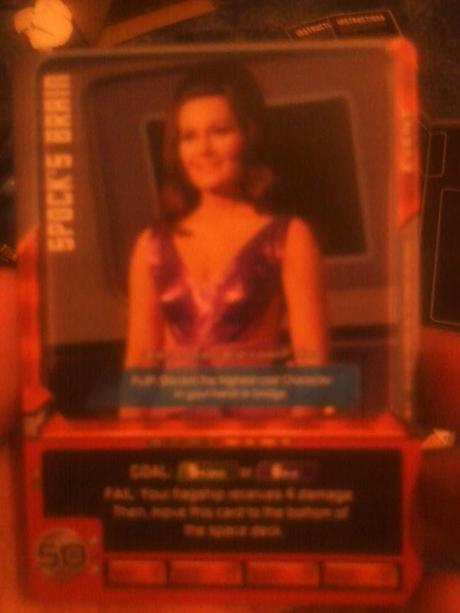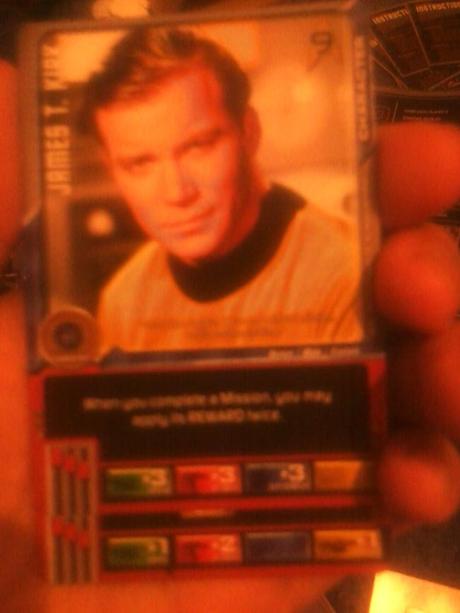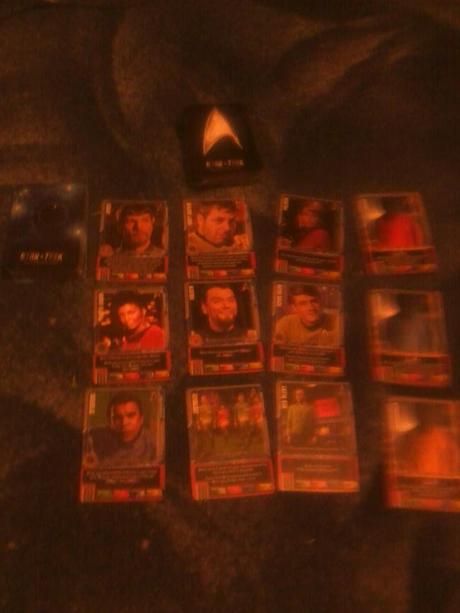
Star Trek: The Original Series Deck Building Game was designed by Alex Bykov and published by Bandai. It’s for 2-4 players and plays in about an hour. I’m going to be giving a general overview of the rules here but I’m not going to go over everything, this is more for my opinion rather than a guide on how to play. For those of you unfamiliar with deck building games, the mechanic is that you start with some basic cards in your hand and you can use them to buy more powerful cards. As you go through your deck the new cards get shuffled in and you can draw them.
First of all I want to talk about something. Look at this box size. Maybe you can’t tell the scale from the picture but it’s fairly big. Now look at what you get inside.

Some cards, dice, and a whooooooooooooole lot of empty space. Maybe they’re trying to be meta and it’s representative of space…the final frontier…but I doubt it. I get that these boxes are made with expansions in mind, but I think you have to be dedicated to an expansion for this to be worthwhile, and it doesn’t look like any expansions are forthcoming. It annoys me. But now, onto the review.
I’m a huge Trekkie. Star Trek is my favorite thing ever so when I saw this game it was almost an insta-buy for me straight away, but I did the diligent thing and checked for reviews but there weren’t too many out there. So the questions are – will this game satisfy a Trekkie’s need? and Will non-Trek fans enjoy this game?
The point of the game is simple, to get the most points. You get points for completing missions (which are based on the episodes). Here’s an example of a mission card.

Everyone’s favorite episode - Spock’s Brain. Sorry for the poor picture quality by the way, but as you can see there’s a fair amount of stuff written on the cards, and this is one of the problems with the game, which I’ll get to later. The number in the bottom left corner is how many points the mission is worth. The typical game goes up to 300 points, but really you can adjust this to however long you want to play. The blue box has a ‘flip’ effect, which is something that happens as you turn the card over. The main text has the goal (what you need to complete the mission) and then the reward. This type is an event, which means that if you are unable to complete it on your turn you have to pay a penalty, which is known as a ‘fail’ condition. Non-event missions will remain in play for other plays to complete, if you are unable to complete it on your turn. You also get secret missions at the start of the game which you can work towards.
But what will you use to complete these missions? Well, you have equipment like tricorders and phases, maneuvers such as a Vulcan mind-meld or energize, and characters like Lt. Kyle, Number One, Spock, and the man himself Captain James T. Kirk.

The number in the Enterprise symbol at the top is the cost of the card. In the black box you have the effect of the card once you play him, and at the bottom you have the card’s statistics (speed, attack, diplomacy and shield). You’ll use these stats to complete missions (for example you may have a mission that requires 5 speed and 3 diplomacy). And as you can see from this picture you can stack the cards to easily see how much of each you currently have. Once you complete a mission you add it to your victory pile and then apply the rewards and any other effects. The play area will look something like this -

On the top left is the mission deck. On your turn you have an explore action which you’ll use to flip over a card and see what mission you have. In the middle are the cards available to buy. As well as an explore action you have a search action, which you can use to replace a card in starbase with one from the deck, located at the top of the picture. To the right are the basic characters that you will be using to buy cards; ensigns, lieutenants and commanders. You’ll always start the game with a number of ensigns and lieutenants but will be able to upgrade them.
There’s also one aspect of the game that I haven’t mentioned and that is the ship battles. Each player has a ship (and the dice that come with the game are used to track hit points). When you battle you’ll add crew and other cards to your ship and the loser will have to discard his whole hand and not draw a new hand until the beginning of his next turn. And that’s pretty much the game.
So first off I want to say that as a Trekkie I really love the theme here, The photos on the cards are great and I love that they’ve used more than just the popular characters. Seeing Pike, Kyle, Bailey, Trelane, Kang, Kor, Palmer, Abraham Lincoln etc is awesome and I like being reminded of the show, and this is helped by having the missions be based on the episodes. It also gives me a kick when I manage to get one of the hero characters, and I’m determined to keep playing this until I get Kirk, Spock and Bones into my hand. But then there’s the game play.
There’s actually a lot I like about this as well. I love that with your starting hand you can actually do stuff. You can’t do anything major, but most of the cards are still useful. For example, one card lets you upgrade a basic character that costs up to two more. Another card lets you discard as many cards as you want and draw that many extra. The ensigns and lieutenants all have effects when you complete missions as well, and this is something that I wish more deck-building games would do because usually your starting cards are pretty much useless. I’m not saying you’ll want to keep an ensign over another type of card, but at least he’s not just dead weight. It gives you a lot more variety of options, and they have stats on them as well, so they can actually help you complete missions.
Speaking of stats, I mentioned it before but I love how you can line up the cards to see what stats you have. It’s such a simple thing but it makes such a difference. It’s streamlined and focused and it just makes things easier to see at a glance.
However, there are a few problems. Firstly, the rulebook. It’s pretty bad. It’s not very well laid out and I had to consult online resources to clear up a few queries. It feels like it was slapped together at the last minute and it leaves a lot of things unclear. Secondly, the text on the cards. There is a lot of it and much of it is confusing, so again you’ll probably have to consult online resources or make up clarifications yourself. It takes a few plays to get everything straightened out and I think if you’re coming into this as a Trekkie first and foremost without being much of a gamer you’ll have a hard time picking things up. Thirdly, the ship battles are just…I’m not even sure what’s going on with those to be honest. It’s kind of cool and you can pretend you doing war games like in The Ultimate Computer, but it seems like much ado about nothing. The end result is that one player has to discard his hand, and ultimately it just doesn’t matter that much. Maybe it’s different in a three or four player game but I’ve only played it two player.
Lastly, the game can feel somewhat formulaic. For example, when you explore it’s more often than not going to be a standard mission, so if you can’t complete it then the player after you will have a chance. This is risky because they’ll have a better chance to prepare for it, like by buying a certain card from starbase, whereas you just have to hope that you’ll be able to complete the mission, so it could get annoying if one player just waits for other players to reveal missions. Sometimes it can feel like you’re just gifting the other player 50 points. This makes the game feel structured because you always want to complete your starting missions first, so it can actually be a long time before the mission deck gets explored, and thus the beginning of the game can feel a little stagnant and dull.
The other thing is that some of the cards are just too useful not to by, like there’s an Energize card that lets you put cards from your discard pile back on top of your deck. This is cool for deck manipulation because I love coming up with those sorts of things, but it can lead to decks feeling very similar game after game, and it’s one of the reasons why I’m saddened that there probably won’t be any expansions. There’s also a tactical scope, which lets you copy the stats of one of the cards in starbase, and there’s no reason for you not to buy that card. So sometimes this can feel like you’re just going through the same cards every time, because they’re the optimal cards to get.
Overall though I have to say that I do enjoy this game. I like that every card does something, even the basic ones. I love the Star Trek feel brought forth from the cards and pictures, and even though some of the things can be confusing they do start to become clearer as you play it more often. I do think, however, that you have to be a Trekkie gamer to like this. I think if you’re purely a fan of the show and don’t know much about games then you’re going to struggle, and I think a big part of the appeal of the game is the fact that it’s Star Trek. I think a gamer will probably feel that there are plenty of other deck building games to try, but for Trekkies this has something extra that makes up for the negative factors. The design of the cards is great (the box size is not) so I think that if you’re a die-hard Trekkie like me then you won’t regret picking it up, but just be aware that it can be a little difficult to wrap your head around at first.
